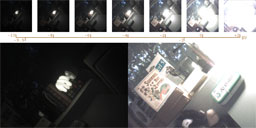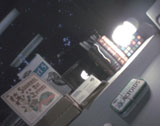High Dynamic Range Images
The dynamic range of an image is the ratio between the brightest
and darkest representable pixel values. In the case of a typical 8-bit
digital image, this is 255:1, or a dynamic range of about 8 stops.
Several units are used to express dynamic range. In photography, the
stop (also called f-stop or EV) is commonly used. One whole stop
(1 EV) is a factor of two in exposure.
The HDReye™ is capable of capturing images with a total
dynamic range of about 26 stops, achieved with a 10-bit CMOS
sensor combined with 16 stops of exposure time control. The captured
image is stored in a floating-point representation so that no dynamic
range is lost due to the storage format.
 This figure shows several exposures extracted from a
single HDReye image. The exposures span a range of 12 stops, and are
shown in two-stop steps. The larger images show portions of the field
of view at two distinct exposures showing that usable image detail is
available over a wide range of exposures.
This figure shows several exposures extracted from a
single HDReye image. The exposures span a range of 12 stops, and are
shown in two-stop steps. The larger images show portions of the field
of view at two distinct exposures showing that usable image detail is
available over a wide range of exposures.
Notice in particular that in the darkest exposures that the light
bulb becomes well-exposed, revealing its structure to be a twisty
compact fluorescent. A small Macbeth chart can be seen in the
background behind the bulb.
In the brighter exposures, the bulb detail is no longer visible,
but the rest of the scene is well-exposed. Details on the album cover,
book cover and candy tin are will lit.
How it Works
When the HDReye's shutter release is activated it automatically
takes a sequence of individual exposures. The actual sequence used for
the image shown above had seventeen exposures ranging in one-stop
steps from 1/16000 s to 4 s. None of those source exposures are shown
in the figure.
The HDReye software on the PC computes a weighted geometric mean
of the estimated irradiance at each pixel in each exposure. A
weighting function emphasises well-exposed pixels, and excludes fully
over-exposed or fully under-exposed pixels from the average. To extend
the range into the saturation region of the sensor, the weights are
modified in the shortest exposure.
Sample Image
 Cropped Sample
(3.65 MB RGB floating point TIFF, 637 x 502 pixels)
Cropped Sample
(3.65 MB RGB floating point TIFF, 637 x 502 pixels)
This is the HDR TIFF post processed to RGB pixels with 32-bit
floating point channels, from which the exposure sequence shown above
was extracted. It has been cropped from the view of a single
facet of the HDReye model 1. A Macbeth mini color checker is visible
behind the compact fluorescent bulb, and the Altoids tin is sitting on
an 18% grey card. The other objects provide a range of typical colors, including
some patches of northern sky visible between leaves of the tree
outside the window.
Cheshire Engineering Corporation
120 West Olive Avenue
Monrovia, California 91016
+1 626 303 1602 Inquiries
+1 626 303 1590 FAX
HDReye@CheshireEng.com.
Copyright © 2004 Cheshire Engineering Corporation. All Rights
Reserved. HDReye™ is a Trademark of Cheshire Engineering
Corporation.
HDRExplained.html last revised August 12, 2004 by Ross Berteig
 This figure shows several exposures extracted from a
single HDReye image. The exposures span a range of 12 stops, and are
shown in two-stop steps. The larger images show portions of the field
of view at two distinct exposures showing that usable image detail is
available over a wide range of exposures.
This figure shows several exposures extracted from a
single HDReye image. The exposures span a range of 12 stops, and are
shown in two-stop steps. The larger images show portions of the field
of view at two distinct exposures showing that usable image detail is
available over a wide range of exposures.